Analyzing Enhanced Auditor Reporting (EAR) at AMP Limited, Australia
VerifiedAdded on 2023/06/07
|14
|3405
|261
Case Study
AI Summary
This case study examines the adoption of Enhanced Auditor Reporting (EAR) in Australia, focusing on AMP Limited as a case study. Following international standards, Australia implemented EAR to enhance information value and transparency in auditor reporting. The study highlights the shift from traditional one-page audit reports to more informative reports that include Key Audit Matters (KAMs) and going concern assessments. The analysis of AMP Limited's 2017 annual report, audited by Ernst & Young, reveals how KAMs such as valuation of life insurance policy liabilities, investment contract liabilities, complex financial investments, and recoverability of goodwill and intangible assets were identified and addressed. The auditor's procedures for each KAM are detailed, showcasing the enhanced scrutiny and transparency required under the new standards. The report concludes that EAR has led to more insightful disclosures, improved quality of information, and increased satisfaction among shareholders, marking a significant step forward in financial reporting in Australia. Desklib provides access to this and other solved assignments.

Auditor Reporting 1
Enhanced Auditor Reporting
by Student Name
Course and Course Code
Professor
University Name
City & State
Date
Enhanced Auditor Reporting
by Student Name
Course and Course Code
Professor
University Name
City & State
Date
Paraphrase This Document
Need a fresh take? Get an instant paraphrase of this document with our AI Paraphraser
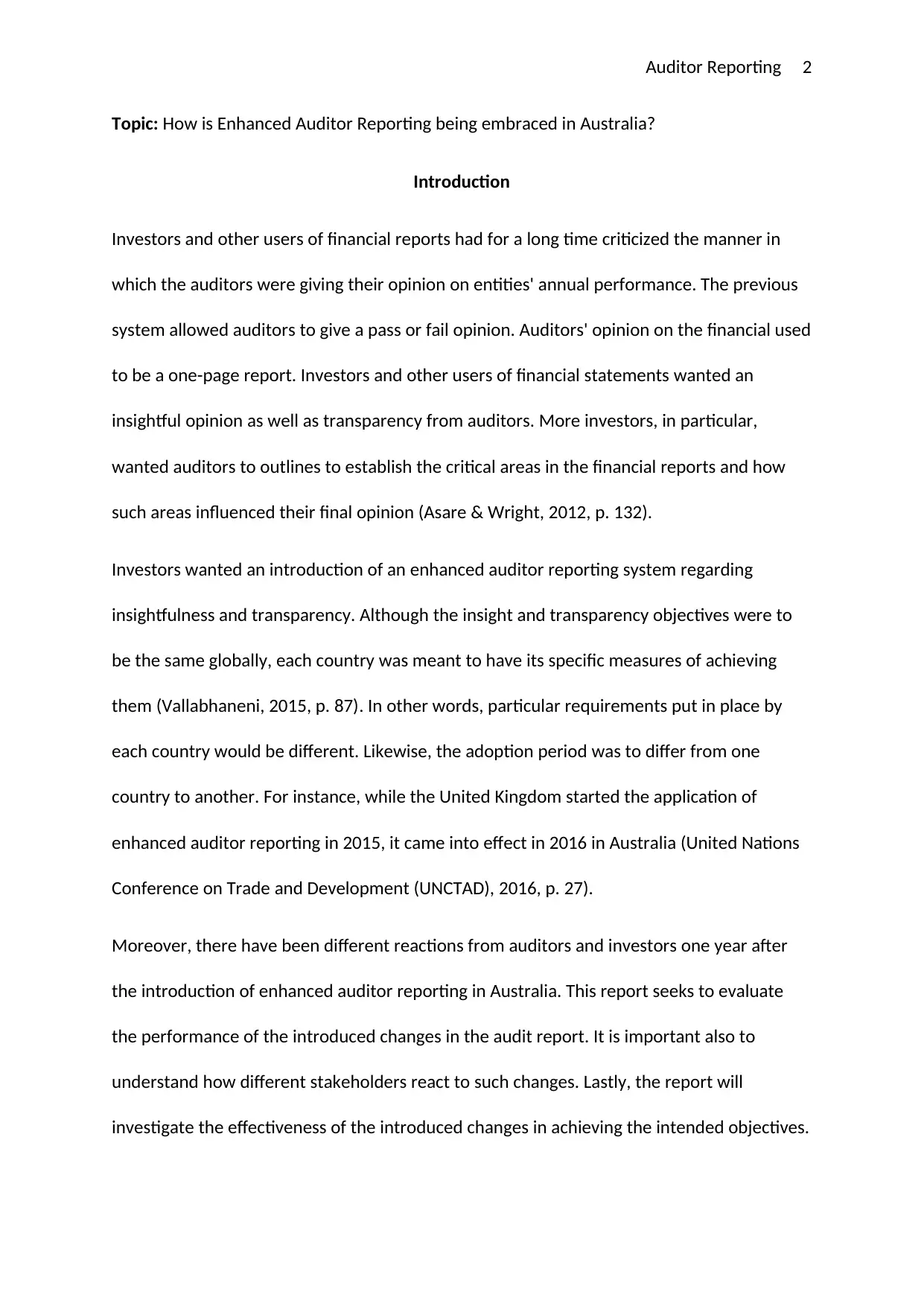
Auditor Reporting 2
Topic: How is Enhanced Auditor Reporting being embraced in Australia?
Introduction
Investors and other users of financial reports had for a long time criticized the manner in
which the auditors were giving their opinion on entities' annual performance. The previous
system allowed auditors to give a pass or fail opinion. Auditors' opinion on the financial used
to be a one-page report. Investors and other users of financial statements wanted an
insightful opinion as well as transparency from auditors. More investors, in particular,
wanted auditors to outlines to establish the critical areas in the financial reports and how
such areas influenced their final opinion (Asare & Wright, 2012, p. 132).
Investors wanted an introduction of an enhanced auditor reporting system regarding
insightfulness and transparency. Although the insight and transparency objectives were to
be the same globally, each country was meant to have its specific measures of achieving
them (Vallabhaneni, 2015, p. 87). In other words, particular requirements put in place by
each country would be different. Likewise, the adoption period was to differ from one
country to another. For instance, while the United Kingdom started the application of
enhanced auditor reporting in 2015, it came into effect in 2016 in Australia (United Nations
Conference on Trade and Development (UNCTAD), 2016, p. 27).
Moreover, there have been different reactions from auditors and investors one year after
the introduction of enhanced auditor reporting in Australia. This report seeks to evaluate
the performance of the introduced changes in the audit report. It is important also to
understand how different stakeholders react to such changes. Lastly, the report will
investigate the effectiveness of the introduced changes in achieving the intended objectives.
Topic: How is Enhanced Auditor Reporting being embraced in Australia?
Introduction
Investors and other users of financial reports had for a long time criticized the manner in
which the auditors were giving their opinion on entities' annual performance. The previous
system allowed auditors to give a pass or fail opinion. Auditors' opinion on the financial used
to be a one-page report. Investors and other users of financial statements wanted an
insightful opinion as well as transparency from auditors. More investors, in particular,
wanted auditors to outlines to establish the critical areas in the financial reports and how
such areas influenced their final opinion (Asare & Wright, 2012, p. 132).
Investors wanted an introduction of an enhanced auditor reporting system regarding
insightfulness and transparency. Although the insight and transparency objectives were to
be the same globally, each country was meant to have its specific measures of achieving
them (Vallabhaneni, 2015, p. 87). In other words, particular requirements put in place by
each country would be different. Likewise, the adoption period was to differ from one
country to another. For instance, while the United Kingdom started the application of
enhanced auditor reporting in 2015, it came into effect in 2016 in Australia (United Nations
Conference on Trade and Development (UNCTAD), 2016, p. 27).
Moreover, there have been different reactions from auditors and investors one year after
the introduction of enhanced auditor reporting in Australia. This report seeks to evaluate
the performance of the introduced changes in the audit report. It is important also to
understand how different stakeholders react to such changes. Lastly, the report will
investigate the effectiveness of the introduced changes in achieving the intended objectives.
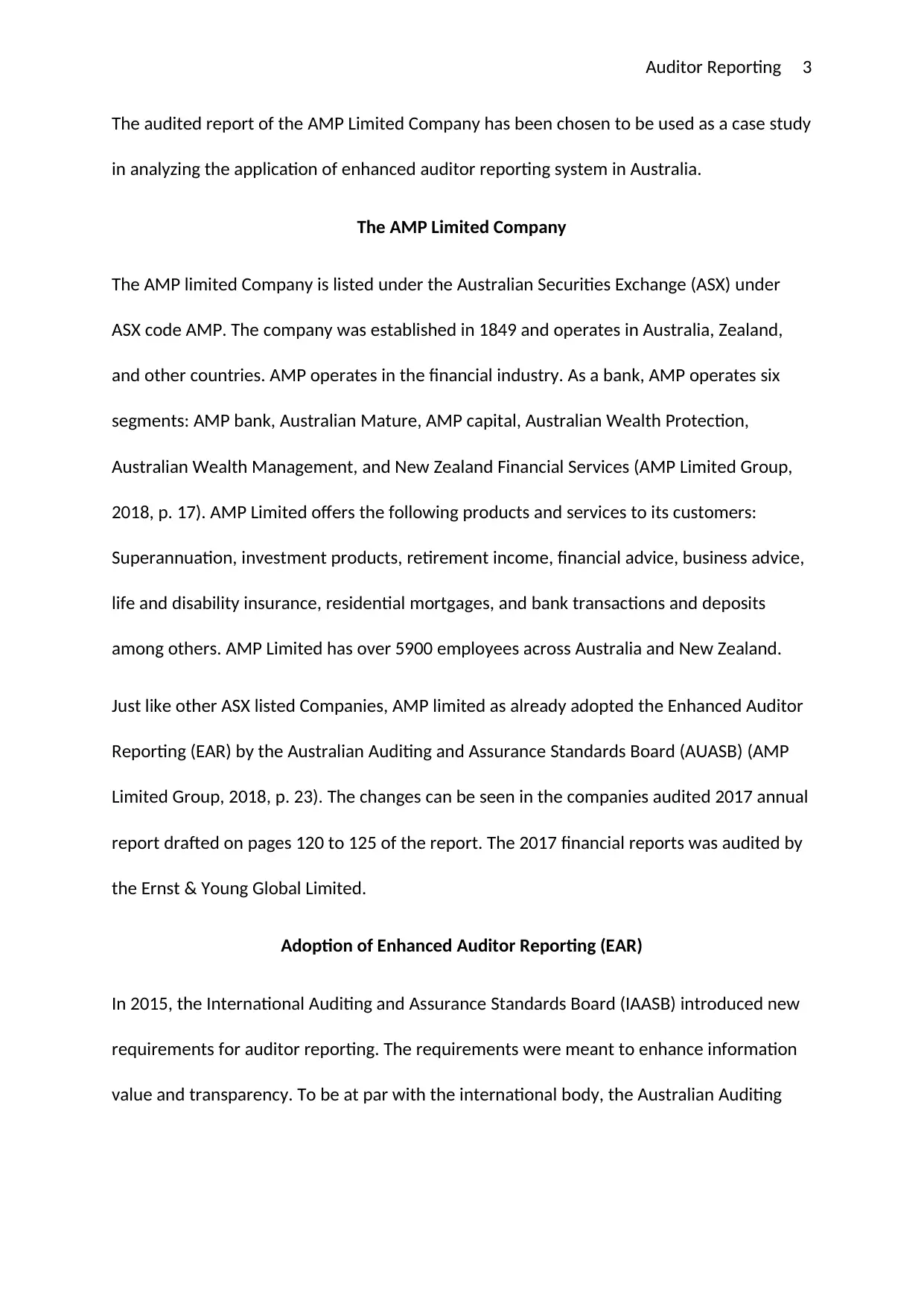
Auditor Reporting 3
The audited report of the AMP Limited Company has been chosen to be used as a case study
in analyzing the application of enhanced auditor reporting system in Australia.
The AMP Limited Company
The AMP limited Company is listed under the Australian Securities Exchange (ASX) under
ASX code AMP. The company was established in 1849 and operates in Australia, Zealand,
and other countries. AMP operates in the financial industry. As a bank, AMP operates six
segments: AMP bank, Australian Mature, AMP capital, Australian Wealth Protection,
Australian Wealth Management, and New Zealand Financial Services (AMP Limited Group,
2018, p. 17). AMP Limited offers the following products and services to its customers:
Superannuation, investment products, retirement income, financial advice, business advice,
life and disability insurance, residential mortgages, and bank transactions and deposits
among others. AMP Limited has over 5900 employees across Australia and New Zealand.
Just like other ASX listed Companies, AMP limited as already adopted the Enhanced Auditor
Reporting (EAR) by the Australian Auditing and Assurance Standards Board (AUASB) (AMP
Limited Group, 2018, p. 23). The changes can be seen in the companies audited 2017 annual
report drafted on pages 120 to 125 of the report. The 2017 financial reports was audited by
the Ernst & Young Global Limited.
Adoption of Enhanced Auditor Reporting (EAR)
In 2015, the International Auditing and Assurance Standards Board (IAASB) introduced new
requirements for auditor reporting. The requirements were meant to enhance information
value and transparency. To be at par with the international body, the Australian Auditing
The audited report of the AMP Limited Company has been chosen to be used as a case study
in analyzing the application of enhanced auditor reporting system in Australia.
The AMP Limited Company
The AMP limited Company is listed under the Australian Securities Exchange (ASX) under
ASX code AMP. The company was established in 1849 and operates in Australia, Zealand,
and other countries. AMP operates in the financial industry. As a bank, AMP operates six
segments: AMP bank, Australian Mature, AMP capital, Australian Wealth Protection,
Australian Wealth Management, and New Zealand Financial Services (AMP Limited Group,
2018, p. 17). AMP Limited offers the following products and services to its customers:
Superannuation, investment products, retirement income, financial advice, business advice,
life and disability insurance, residential mortgages, and bank transactions and deposits
among others. AMP Limited has over 5900 employees across Australia and New Zealand.
Just like other ASX listed Companies, AMP limited as already adopted the Enhanced Auditor
Reporting (EAR) by the Australian Auditing and Assurance Standards Board (AUASB) (AMP
Limited Group, 2018, p. 23). The changes can be seen in the companies audited 2017 annual
report drafted on pages 120 to 125 of the report. The 2017 financial reports was audited by
the Ernst & Young Global Limited.
Adoption of Enhanced Auditor Reporting (EAR)
In 2015, the International Auditing and Assurance Standards Board (IAASB) introduced new
requirements for auditor reporting. The requirements were meant to enhance information
value and transparency. To be at par with the international body, the Australian Auditing
⊘ This is a preview!⊘
Do you want full access?
Subscribe today to unlock all pages.

Trusted by 1+ million students worldwide

Auditor Reporting 4
and Assurance Standards Board (AUASB) also adopted similar regulations which became
effective on or after December 15th, 2016 (Moroney et al., 2017, p. 19).
Proposed Changes
Before the introduction of the EAR, the traditional audit report was a one-page document.
The auditors were only required to state whether or not the report had passed based on
their opinion. It was not an auditor's responsibility to provide a more informative and
insightful report. However, the newly adopted requirement advocate for information value
and transparency from auditors (Dagwell, et al., 2015, p. 79).
EAR introduced two main changes in auditor reporting:
First, the new system introduced the key audit matters (KAMs). Auditors are required to list
keys areas that they assessed during the audit and how such areas impacted the entire audit
process. Key audit matters refer to areas that identified to pose significant risks to the
company's performance (Houghton, et al., 2010, p. 213). Such areas include significant
transactions during the financial year, likely misstatements, and key management decisions
like investment valuations and estimations. In their discussion, auditors are required to
explain how they addressed the identified KAMs. Therefore, KAMs was introduced to inform
the investors and other external users of financial information about the discussions that
took place auditor, the management and the company's audit team (Greenhalgh, 2017).
The second aspect of the changes relates to an entity's going concern. Going concern is
referred to a company's ability to continue operating into an unforeseeable future. Under
the traditional auditing system, auditors were only required to point out material
uncertainties that would negatively impact a company's going concern (Brunelli, 2018, p.
and Assurance Standards Board (AUASB) also adopted similar regulations which became
effective on or after December 15th, 2016 (Moroney et al., 2017, p. 19).
Proposed Changes
Before the introduction of the EAR, the traditional audit report was a one-page document.
The auditors were only required to state whether or not the report had passed based on
their opinion. It was not an auditor's responsibility to provide a more informative and
insightful report. However, the newly adopted requirement advocate for information value
and transparency from auditors (Dagwell, et al., 2015, p. 79).
EAR introduced two main changes in auditor reporting:
First, the new system introduced the key audit matters (KAMs). Auditors are required to list
keys areas that they assessed during the audit and how such areas impacted the entire audit
process. Key audit matters refer to areas that identified to pose significant risks to the
company's performance (Houghton, et al., 2010, p. 213). Such areas include significant
transactions during the financial year, likely misstatements, and key management decisions
like investment valuations and estimations. In their discussion, auditors are required to
explain how they addressed the identified KAMs. Therefore, KAMs was introduced to inform
the investors and other external users of financial information about the discussions that
took place auditor, the management and the company's audit team (Greenhalgh, 2017).
The second aspect of the changes relates to an entity's going concern. Going concern is
referred to a company's ability to continue operating into an unforeseeable future. Under
the traditional auditing system, auditors were only required to point out material
uncertainties that would negatively impact a company's going concern (Brunelli, 2018, p.
Paraphrase This Document
Need a fresh take? Get an instant paraphrase of this document with our AI Paraphraser
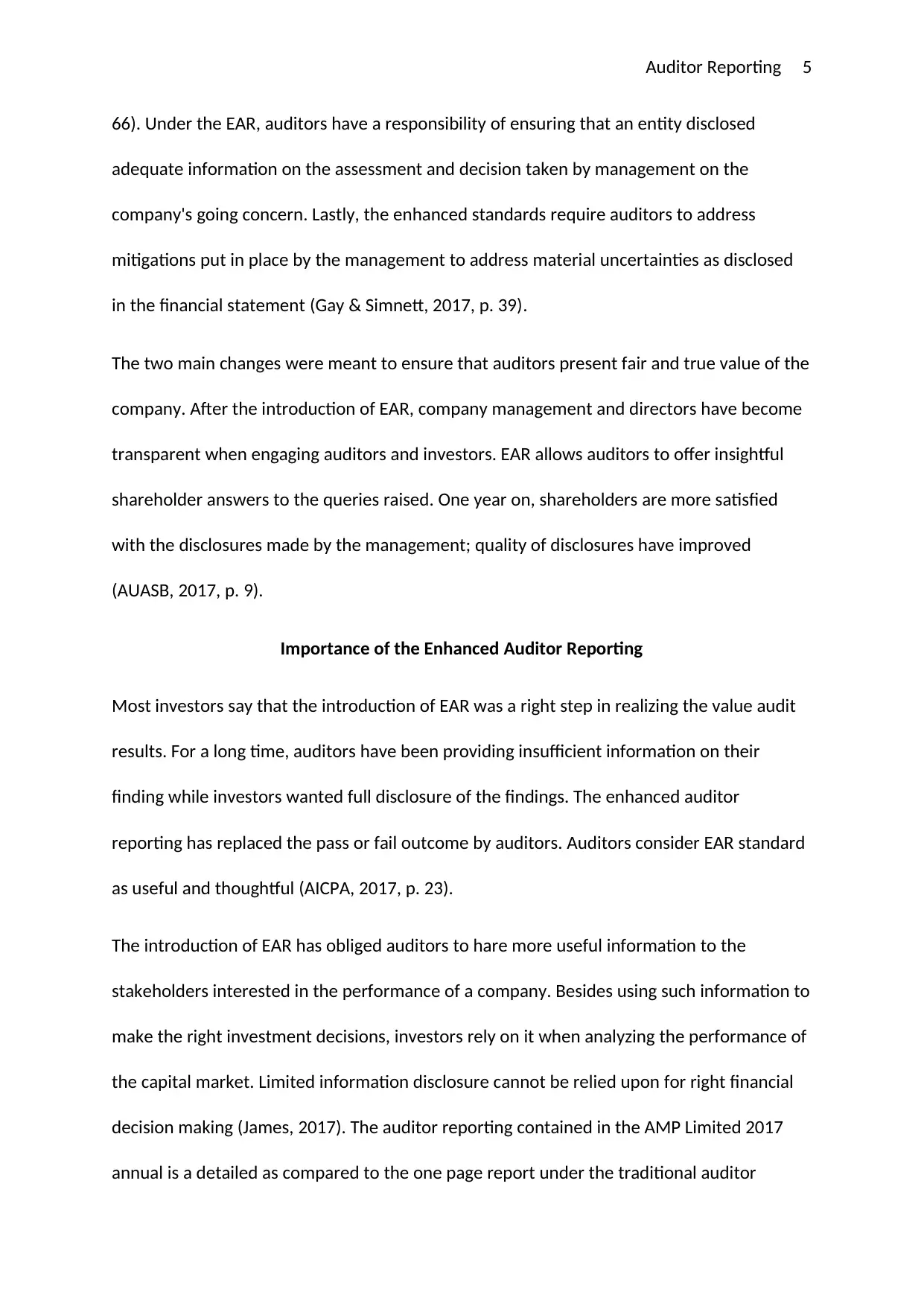
Auditor Reporting 5
66). Under the EAR, auditors have a responsibility of ensuring that an entity disclosed
adequate information on the assessment and decision taken by management on the
company's going concern. Lastly, the enhanced standards require auditors to address
mitigations put in place by the management to address material uncertainties as disclosed
in the financial statement (Gay & Simnett, 2017, p. 39).
The two main changes were meant to ensure that auditors present fair and true value of the
company. After the introduction of EAR, company management and directors have become
transparent when engaging auditors and investors. EAR allows auditors to offer insightful
shareholder answers to the queries raised. One year on, shareholders are more satisfied
with the disclosures made by the management; quality of disclosures have improved
(AUASB, 2017, p. 9).
Importance of the Enhanced Auditor Reporting
Most investors say that the introduction of EAR was a right step in realizing the value audit
results. For a long time, auditors have been providing insufficient information on their
finding while investors wanted full disclosure of the findings. The enhanced auditor
reporting has replaced the pass or fail outcome by auditors. Auditors consider EAR standard
as useful and thoughtful (AICPA, 2017, p. 23).
The introduction of EAR has obliged auditors to hare more useful information to the
stakeholders interested in the performance of a company. Besides using such information to
make the right investment decisions, investors rely on it when analyzing the performance of
the capital market. Limited information disclosure cannot be relied upon for right financial
decision making (James, 2017). The auditor reporting contained in the AMP Limited 2017
annual is a detailed as compared to the one page report under the traditional auditor
66). Under the EAR, auditors have a responsibility of ensuring that an entity disclosed
adequate information on the assessment and decision taken by management on the
company's going concern. Lastly, the enhanced standards require auditors to address
mitigations put in place by the management to address material uncertainties as disclosed
in the financial statement (Gay & Simnett, 2017, p. 39).
The two main changes were meant to ensure that auditors present fair and true value of the
company. After the introduction of EAR, company management and directors have become
transparent when engaging auditors and investors. EAR allows auditors to offer insightful
shareholder answers to the queries raised. One year on, shareholders are more satisfied
with the disclosures made by the management; quality of disclosures have improved
(AUASB, 2017, p. 9).
Importance of the Enhanced Auditor Reporting
Most investors say that the introduction of EAR was a right step in realizing the value audit
results. For a long time, auditors have been providing insufficient information on their
finding while investors wanted full disclosure of the findings. The enhanced auditor
reporting has replaced the pass or fail outcome by auditors. Auditors consider EAR standard
as useful and thoughtful (AICPA, 2017, p. 23).
The introduction of EAR has obliged auditors to hare more useful information to the
stakeholders interested in the performance of a company. Besides using such information to
make the right investment decisions, investors rely on it when analyzing the performance of
the capital market. Limited information disclosure cannot be relied upon for right financial
decision making (James, 2017). The auditor reporting contained in the AMP Limited 2017
annual is a detailed as compared to the one page report under the traditional auditor
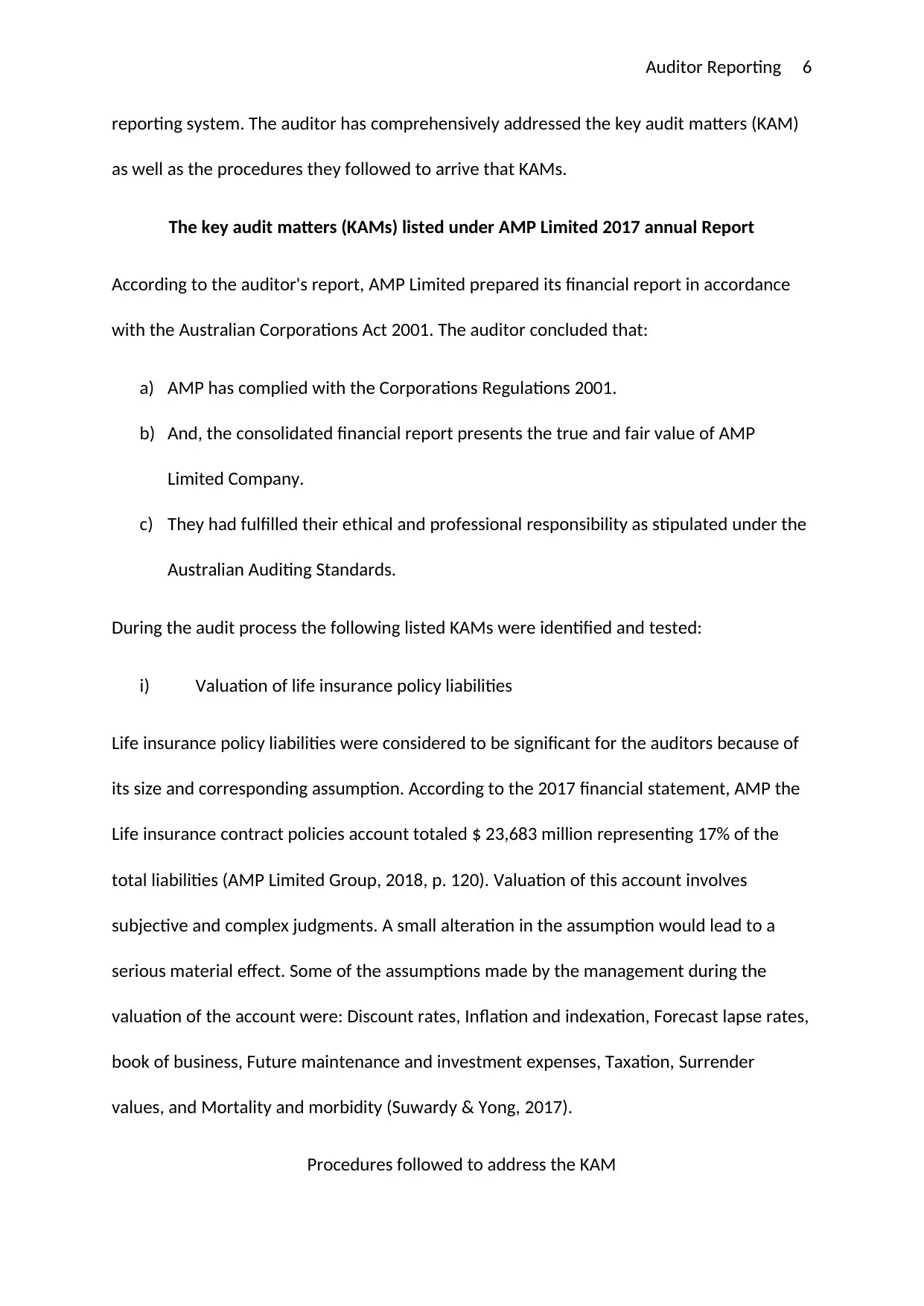
Auditor Reporting 6
reporting system. The auditor has comprehensively addressed the key audit matters (KAM)
as well as the procedures they followed to arrive that KAMs.
The key audit matters (KAMs) listed under AMP Limited 2017 annual Report
According to the auditor's report, AMP Limited prepared its financial report in accordance
with the Australian Corporations Act 2001. The auditor concluded that:
a) AMP has complied with the Corporations Regulations 2001.
b) And, the consolidated financial report presents the true and fair value of AMP
Limited Company.
c) They had fulfilled their ethical and professional responsibility as stipulated under the
Australian Auditing Standards.
During the audit process the following listed KAMs were identified and tested:
i) Valuation of life insurance policy liabilities
Life insurance policy liabilities were considered to be significant for the auditors because of
its size and corresponding assumption. According to the 2017 financial statement, AMP the
Life insurance contract policies account totaled $ 23,683 million representing 17% of the
total liabilities (AMP Limited Group, 2018, p. 120). Valuation of this account involves
subjective and complex judgments. A small alteration in the assumption would lead to a
serious material effect. Some of the assumptions made by the management during the
valuation of the account were: Discount rates, Inflation and indexation, Forecast lapse rates,
book of business, Future maintenance and investment expenses, Taxation, Surrender
values, and Mortality and morbidity (Suwardy & Yong, 2017).
Procedures followed to address the KAM
reporting system. The auditor has comprehensively addressed the key audit matters (KAM)
as well as the procedures they followed to arrive that KAMs.
The key audit matters (KAMs) listed under AMP Limited 2017 annual Report
According to the auditor's report, AMP Limited prepared its financial report in accordance
with the Australian Corporations Act 2001. The auditor concluded that:
a) AMP has complied with the Corporations Regulations 2001.
b) And, the consolidated financial report presents the true and fair value of AMP
Limited Company.
c) They had fulfilled their ethical and professional responsibility as stipulated under the
Australian Auditing Standards.
During the audit process the following listed KAMs were identified and tested:
i) Valuation of life insurance policy liabilities
Life insurance policy liabilities were considered to be significant for the auditors because of
its size and corresponding assumption. According to the 2017 financial statement, AMP the
Life insurance contract policies account totaled $ 23,683 million representing 17% of the
total liabilities (AMP Limited Group, 2018, p. 120). Valuation of this account involves
subjective and complex judgments. A small alteration in the assumption would lead to a
serious material effect. Some of the assumptions made by the management during the
valuation of the account were: Discount rates, Inflation and indexation, Forecast lapse rates,
book of business, Future maintenance and investment expenses, Taxation, Surrender
values, and Mortality and morbidity (Suwardy & Yong, 2017).
Procedures followed to address the KAM
⊘ This is a preview!⊘
Do you want full access?
Subscribe today to unlock all pages.

Trusted by 1+ million students worldwide

Auditor Reporting 7
First, the auditors assessed the company internal control over policy administration, claims
processes and recording new businesses. Second, auditors investigated the process used to
value policy liability by reconciling the data that was used to support the valuation process.
Third, assessing the effectiveness of the IT system controls used for policy valuation. Fourth,
auditors evaluated the objectivity and completeness of the company's life entities (AMP
Limited Group, 2018, p. 120). Fifth, auditors, an actuarial specialist evaluated how
reasonable were the key assumptions and valuation methodology and how they impacted
the life insurance policy. Lastly, the accrual specialists tested the validated of the changes
made in the valuation model and how they impacted the final outcome of the account.
ii) Valuation of investment contract liabilities
Valuation of investment contract liabilities was treated as KAM because of its size.
According to the AMP 2017 financial statement, the account was valued at $ 75, 235 million
representing 53% of the total liabilities (AMP Limited Group, 2018, p. 121).
The Valuation of investment contract liabilities account was significant to the auditors
because it comprised of investment management and financial instrument elements. The
two elements were presented at their fair value. The account has a direct impact on the
valuation and performance of AMP assets. Likewise, fair value was determined using unit
prices published by a third party and not internal judgment. Therefore, it is important to
assess the reasonability of using third party price units to determine the fair value of
account elements (AMP Limited Group, 2018, p. 121).
First, the auditors assessed the company internal control over policy administration, claims
processes and recording new businesses. Second, auditors investigated the process used to
value policy liability by reconciling the data that was used to support the valuation process.
Third, assessing the effectiveness of the IT system controls used for policy valuation. Fourth,
auditors evaluated the objectivity and completeness of the company's life entities (AMP
Limited Group, 2018, p. 120). Fifth, auditors, an actuarial specialist evaluated how
reasonable were the key assumptions and valuation methodology and how they impacted
the life insurance policy. Lastly, the accrual specialists tested the validated of the changes
made in the valuation model and how they impacted the final outcome of the account.
ii) Valuation of investment contract liabilities
Valuation of investment contract liabilities was treated as KAM because of its size.
According to the AMP 2017 financial statement, the account was valued at $ 75, 235 million
representing 53% of the total liabilities (AMP Limited Group, 2018, p. 121).
The Valuation of investment contract liabilities account was significant to the auditors
because it comprised of investment management and financial instrument elements. The
two elements were presented at their fair value. The account has a direct impact on the
valuation and performance of AMP assets. Likewise, fair value was determined using unit
prices published by a third party and not internal judgment. Therefore, it is important to
assess the reasonability of using third party price units to determine the fair value of
account elements (AMP Limited Group, 2018, p. 121).
Paraphrase This Document
Need a fresh take? Get an instant paraphrase of this document with our AI Paraphraser
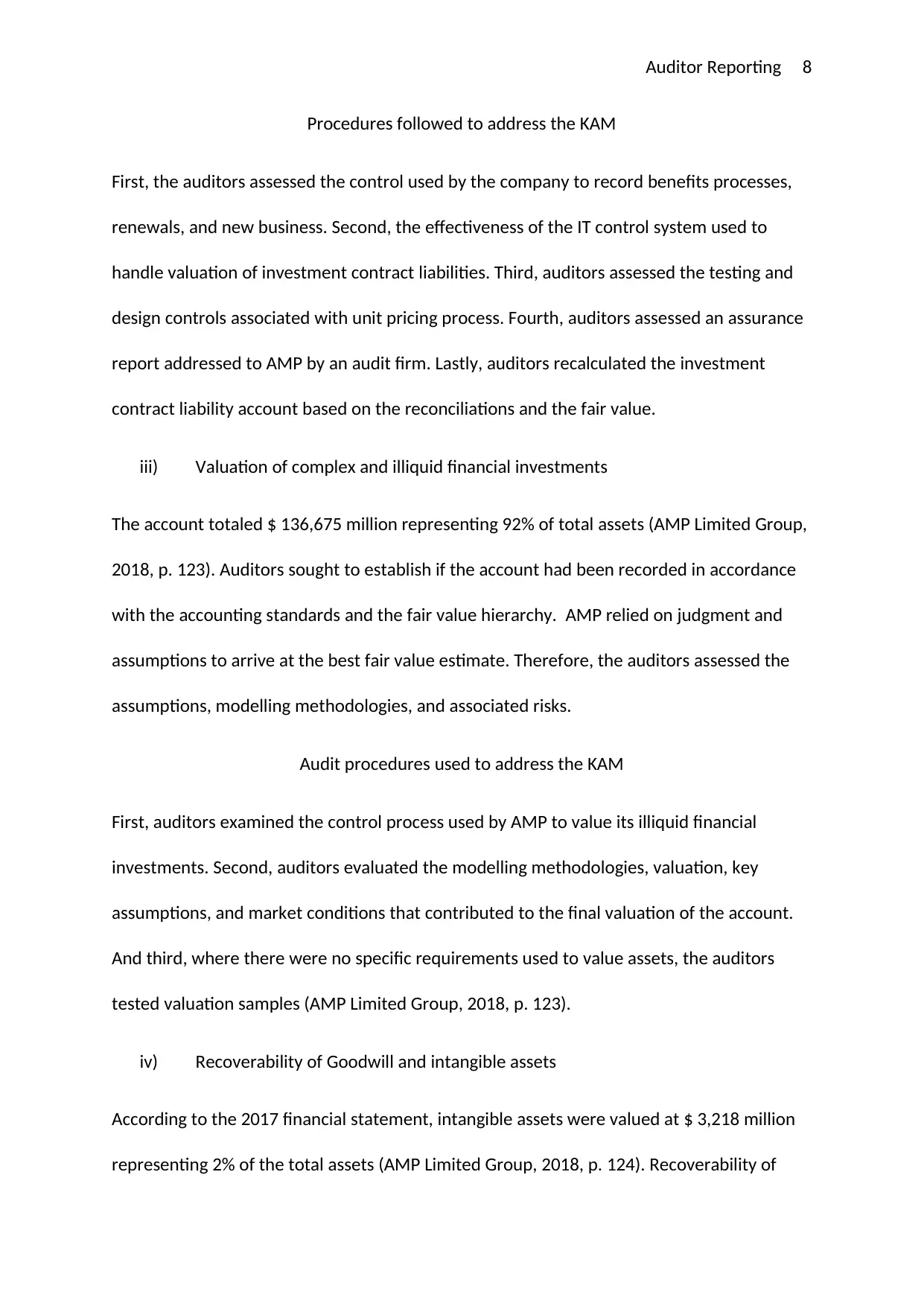
Auditor Reporting 8
Procedures followed to address the KAM
First, the auditors assessed the control used by the company to record benefits processes,
renewals, and new business. Second, the effectiveness of the IT control system used to
handle valuation of investment contract liabilities. Third, auditors assessed the testing and
design controls associated with unit pricing process. Fourth, auditors assessed an assurance
report addressed to AMP by an audit firm. Lastly, auditors recalculated the investment
contract liability account based on the reconciliations and the fair value.
iii) Valuation of complex and illiquid financial investments
The account totaled $ 136,675 million representing 92% of total assets (AMP Limited Group,
2018, p. 123). Auditors sought to establish if the account had been recorded in accordance
with the accounting standards and the fair value hierarchy. AMP relied on judgment and
assumptions to arrive at the best fair value estimate. Therefore, the auditors assessed the
assumptions, modelling methodologies, and associated risks.
Audit procedures used to address the KAM
First, auditors examined the control process used by AMP to value its illiquid financial
investments. Second, auditors evaluated the modelling methodologies, valuation, key
assumptions, and market conditions that contributed to the final valuation of the account.
And third, where there were no specific requirements used to value assets, the auditors
tested valuation samples (AMP Limited Group, 2018, p. 123).
iv) Recoverability of Goodwill and intangible assets
According to the 2017 financial statement, intangible assets were valued at $ 3,218 million
representing 2% of the total assets (AMP Limited Group, 2018, p. 124). Recoverability of
Procedures followed to address the KAM
First, the auditors assessed the control used by the company to record benefits processes,
renewals, and new business. Second, the effectiveness of the IT control system used to
handle valuation of investment contract liabilities. Third, auditors assessed the testing and
design controls associated with unit pricing process. Fourth, auditors assessed an assurance
report addressed to AMP by an audit firm. Lastly, auditors recalculated the investment
contract liability account based on the reconciliations and the fair value.
iii) Valuation of complex and illiquid financial investments
The account totaled $ 136,675 million representing 92% of total assets (AMP Limited Group,
2018, p. 123). Auditors sought to establish if the account had been recorded in accordance
with the accounting standards and the fair value hierarchy. AMP relied on judgment and
assumptions to arrive at the best fair value estimate. Therefore, the auditors assessed the
assumptions, modelling methodologies, and associated risks.
Audit procedures used to address the KAM
First, auditors examined the control process used by AMP to value its illiquid financial
investments. Second, auditors evaluated the modelling methodologies, valuation, key
assumptions, and market conditions that contributed to the final valuation of the account.
And third, where there were no specific requirements used to value assets, the auditors
tested valuation samples (AMP Limited Group, 2018, p. 123).
iv) Recoverability of Goodwill and intangible assets
According to the 2017 financial statement, intangible assets were valued at $ 3,218 million
representing 2% of the total assets (AMP Limited Group, 2018, p. 124). Recoverability of

Auditor Reporting 9
Goodwill and intangible assets was regarded as a KAM because of complexity involved in
valuation. Valuation of this asset requires a high level of judgement. The judgements arise
from key assumptions that have been taken by the management. Therefore, the auditors
had to test the account for completeness, reasonability, and verifiability (AMP Limited
Group, 2018, p. 124).
Audit procedures used to address the KAM
First, the auditors sought to establish whether or not AMP had completed an assessment of
impairments in accordance with the Australian Accounting Standards. Second auditors
evaluated if the assumptions were consistent with those used to value the life insurance
Contract liabilities. Third, the auditors evaluated the assumptions and methodologies used
to calculate discount rates as well as comparing them with the market rates. Fourth, the
auditors conducted a sensitivity analysis on the key assumptions. Fifth, the auditors used
multiple methods to calculate the valuation of new businesses. Sixth, auditors examined the
methods used by the company to determine CGUs. Lastly, auditors tested mathematical
accuracy of the methods used by AMP to calculate impairment (AMP Limited Group, 2018,
p. 125).
v) Information technology (IT) environment
Information technology (IT) environment is significant for AMP operations. The success of
the company heavily depends on IT systems and controls. The auditors sought to ensure
that the company had put in place appropriate program change management, and access
management. Lastly, auditors wanted to ascertain that the management was adhering to
the existing IT operational protocols (AMP Limited Group, 2018, p. 125).
Goodwill and intangible assets was regarded as a KAM because of complexity involved in
valuation. Valuation of this asset requires a high level of judgement. The judgements arise
from key assumptions that have been taken by the management. Therefore, the auditors
had to test the account for completeness, reasonability, and verifiability (AMP Limited
Group, 2018, p. 124).
Audit procedures used to address the KAM
First, the auditors sought to establish whether or not AMP had completed an assessment of
impairments in accordance with the Australian Accounting Standards. Second auditors
evaluated if the assumptions were consistent with those used to value the life insurance
Contract liabilities. Third, the auditors evaluated the assumptions and methodologies used
to calculate discount rates as well as comparing them with the market rates. Fourth, the
auditors conducted a sensitivity analysis on the key assumptions. Fifth, the auditors used
multiple methods to calculate the valuation of new businesses. Sixth, auditors examined the
methods used by the company to determine CGUs. Lastly, auditors tested mathematical
accuracy of the methods used by AMP to calculate impairment (AMP Limited Group, 2018,
p. 125).
v) Information technology (IT) environment
Information technology (IT) environment is significant for AMP operations. The success of
the company heavily depends on IT systems and controls. The auditors sought to ensure
that the company had put in place appropriate program change management, and access
management. Lastly, auditors wanted to ascertain that the management was adhering to
the existing IT operational protocols (AMP Limited Group, 2018, p. 125).
⊘ This is a preview!⊘
Do you want full access?
Subscribe today to unlock all pages.

Trusted by 1+ million students worldwide

Auditor Reporting 10
Responsibility of Company directors
The auditors went further to discuss the roles and responsibilities of respective parties.
According to the audit report, directors stated that directors were responsible for ‘other
information' contained in the annual report besides their auditor's report. Auditors were not
responsible for ‘other information' contained in the report.
The directors also have a responsibility to give relevant information to the auditors as well
as offer clarification when required by the auditors. The responsibility of preparing financial
reports that gave a true and fair value of the company lied with the directors. Lastly, the
responsibility of assessing the company's going concern lied with the directors.
Conclusion
The report sought to evaluate the impact of enhanced auditor reporting in Australia. The
AMP limited Company is listed under the Australian Securities Exchange (ASX) under ASX
code AMP was used a case study. Before the introduction of the EAR, the traditional audit
report was a one-page document. However, the adoption of the EAR requirement advocate
for information value and transparency from auditors. The 2017 AMP auditors report has
addressed key issues that were considered to be significant by the external auditors. The
new system introduced the key audit matters (KAMs) (AUASB, 2017, p. 22). KAM was
introduced to inform the investors and other external users of financial information about
the discussions that took place auditor, the management and the company's audit team.
While examining the 2017 AMP annual report, auditors identified five KAMs that needed
comprehensive analysis. Under the EAR, auditors have a responsibility of ensuring that an
entity disclosed adequate information about the assessment and decision taken by
management on the company's going concern (AICPA, 2017).
Responsibility of Company directors
The auditors went further to discuss the roles and responsibilities of respective parties.
According to the audit report, directors stated that directors were responsible for ‘other
information' contained in the annual report besides their auditor's report. Auditors were not
responsible for ‘other information' contained in the report.
The directors also have a responsibility to give relevant information to the auditors as well
as offer clarification when required by the auditors. The responsibility of preparing financial
reports that gave a true and fair value of the company lied with the directors. Lastly, the
responsibility of assessing the company's going concern lied with the directors.
Conclusion
The report sought to evaluate the impact of enhanced auditor reporting in Australia. The
AMP limited Company is listed under the Australian Securities Exchange (ASX) under ASX
code AMP was used a case study. Before the introduction of the EAR, the traditional audit
report was a one-page document. However, the adoption of the EAR requirement advocate
for information value and transparency from auditors. The 2017 AMP auditors report has
addressed key issues that were considered to be significant by the external auditors. The
new system introduced the key audit matters (KAMs) (AUASB, 2017, p. 22). KAM was
introduced to inform the investors and other external users of financial information about
the discussions that took place auditor, the management and the company's audit team.
While examining the 2017 AMP annual report, auditors identified five KAMs that needed
comprehensive analysis. Under the EAR, auditors have a responsibility of ensuring that an
entity disclosed adequate information about the assessment and decision taken by
management on the company's going concern (AICPA, 2017).
Paraphrase This Document
Need a fresh take? Get an instant paraphrase of this document with our AI Paraphraser
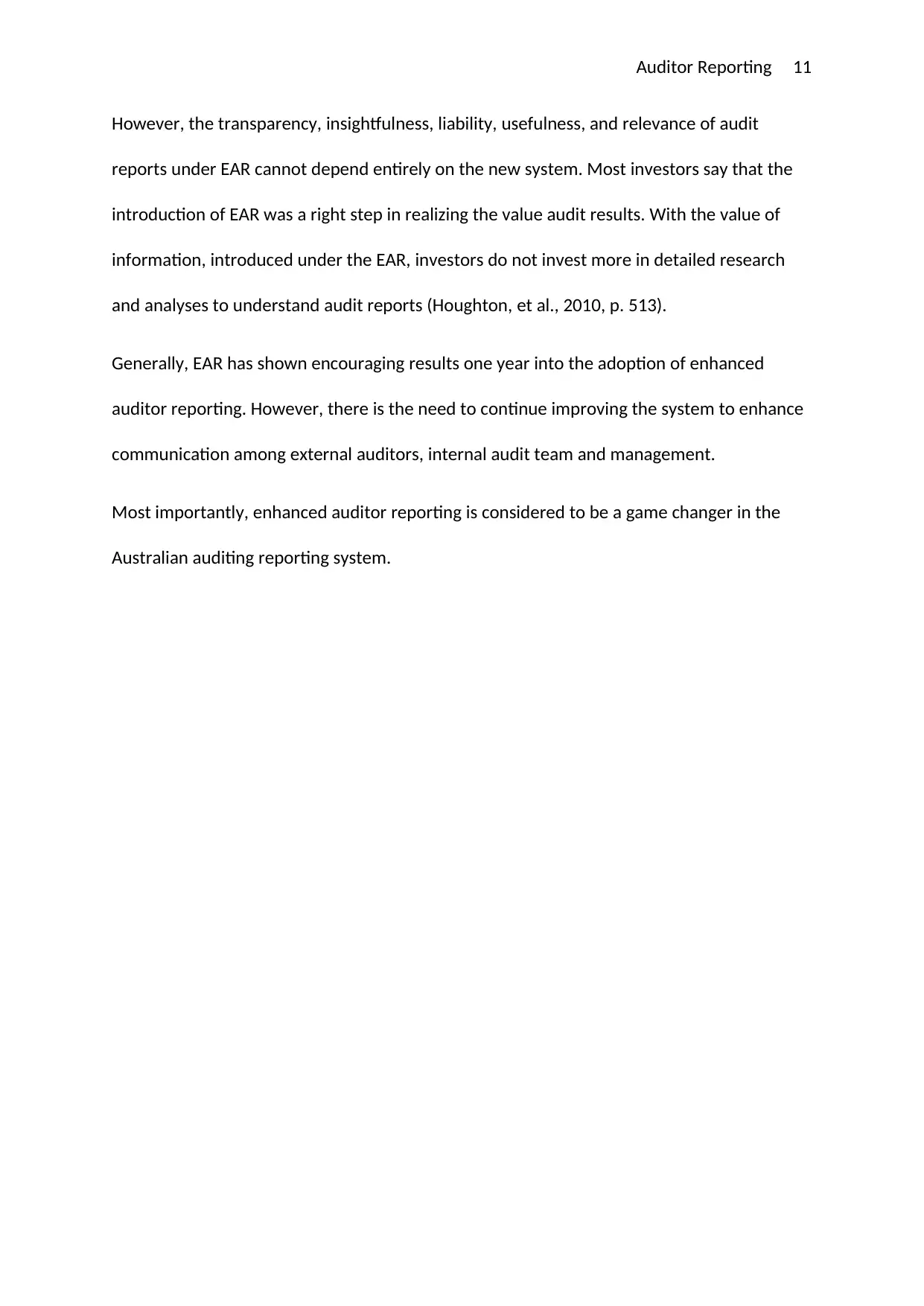
Auditor Reporting 11
However, the transparency, insightfulness, liability, usefulness, and relevance of audit
reports under EAR cannot depend entirely on the new system. Most investors say that the
introduction of EAR was a right step in realizing the value audit results. With the value of
information, introduced under the EAR, investors do not invest more in detailed research
and analyses to understand audit reports (Houghton, et al., 2010, p. 513).
Generally, EAR has shown encouraging results one year into the adoption of enhanced
auditor reporting. However, there is the need to continue improving the system to enhance
communication among external auditors, internal audit team and management.
Most importantly, enhanced auditor reporting is considered to be a game changer in the
Australian auditing reporting system.
However, the transparency, insightfulness, liability, usefulness, and relevance of audit
reports under EAR cannot depend entirely on the new system. Most investors say that the
introduction of EAR was a right step in realizing the value audit results. With the value of
information, introduced under the EAR, investors do not invest more in detailed research
and analyses to understand audit reports (Houghton, et al., 2010, p. 513).
Generally, EAR has shown encouraging results one year into the adoption of enhanced
auditor reporting. However, there is the need to continue improving the system to enhance
communication among external auditors, internal audit team and management.
Most importantly, enhanced auditor reporting is considered to be a game changer in the
Australian auditing reporting system.

Auditor Reporting 12
References List
AICPA, 2017. Audit and Accounting Guide: Investment Companies, 2017. New York: John
Wiley & Sons.
AMP Limited Group, 2018. 2017 Annual Report. Sydney: AMP Limited Group.
Asare, S. K. & Wright, A. M., 2012. Investors’, auditors’, and lenders’ understanding of the
message conveyed by the standard audit report on the financial statements. Accounting
Horizons, 26(2), pp. 193-217.
AUASB, 2017. Auditing Standard ASA 701 Communicating Key Audit Matters in the
Independent Auditor’s Report, Melbourne Victoria: Auditing and Assurance Standards Board.
Brunelli, S., 2018. Audit Reporting for Going Concern Uncertainty: Global Trends and the
Case Study of Italy. New York: Springer.
Dagwell, R., Wines, G. & Lambert, C., 2015. Corporate Accounting in Australia. Sydney:
Pearson Higher Education AU.
Gay, G. & Simnett, R., 2017. Auditing and Assurance Services in Australia. Sydney: McGraw-
Hill Education Australia.
Gay, G. & Simnett, R., 2018. Auditing and Assurance Services in Australia. Seventh Edition
ed. New Tork: McGraw-Hill Education.
Greenhalgh, J., 2017. Why 'Key Audit Matters' matter. [Online]
Available at: https://www.investsmart.com.au/investment-news/why-key-audit-matters-
matter/139748
[Accessed 13 09 2018].
References List
AICPA, 2017. Audit and Accounting Guide: Investment Companies, 2017. New York: John
Wiley & Sons.
AMP Limited Group, 2018. 2017 Annual Report. Sydney: AMP Limited Group.
Asare, S. K. & Wright, A. M., 2012. Investors’, auditors’, and lenders’ understanding of the
message conveyed by the standard audit report on the financial statements. Accounting
Horizons, 26(2), pp. 193-217.
AUASB, 2017. Auditing Standard ASA 701 Communicating Key Audit Matters in the
Independent Auditor’s Report, Melbourne Victoria: Auditing and Assurance Standards Board.
Brunelli, S., 2018. Audit Reporting for Going Concern Uncertainty: Global Trends and the
Case Study of Italy. New York: Springer.
Dagwell, R., Wines, G. & Lambert, C., 2015. Corporate Accounting in Australia. Sydney:
Pearson Higher Education AU.
Gay, G. & Simnett, R., 2017. Auditing and Assurance Services in Australia. Sydney: McGraw-
Hill Education Australia.
Gay, G. & Simnett, R., 2018. Auditing and Assurance Services in Australia. Seventh Edition
ed. New Tork: McGraw-Hill Education.
Greenhalgh, J., 2017. Why 'Key Audit Matters' matter. [Online]
Available at: https://www.investsmart.com.au/investment-news/why-key-audit-matters-
matter/139748
[Accessed 13 09 2018].
⊘ This is a preview!⊘
Do you want full access?
Subscribe today to unlock all pages.

Trusted by 1+ million students worldwide
1 out of 14
Related Documents
Your All-in-One AI-Powered Toolkit for Academic Success.
+13062052269
info@desklib.com
Available 24*7 on WhatsApp / Email
![[object Object]](/_next/static/media/star-bottom.7253800d.svg)
Unlock your academic potential
Copyright © 2020–2025 A2Z Services. All Rights Reserved. Developed and managed by ZUCOL.





